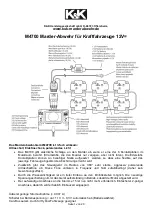
Note: If you are checking tire pressure
when the tire is hot, (for example driven
more than 1 mile [1.6 kilometers]), never
bleed or reduce air pressure. The tires
are hot from driving and it is normal for
pressures to increase above
recommended cold pressures. A hot tire
at or below recommended cold inflation
pressure could be significantly
under-inflated.
Note: If you have to drive a distance to
get air for your tire(s), check and record
the tire pressure first and add the
appropriate air pressure when you get
to the pump. It is normal for tires to heat
up and the air pressure inside to go up
as you drive.
2. Remove the cap from the valve on
one tire, then firmly press the tire
gauge onto the valve and measure
the pressure.
3. Add enough air to reach the
recommended air pressure.
Note: If you overfill the tire, release air
by pressing on the metal stem in the
center of the valve. Then recheck the
pressure with your tire gauge.
4. Replace the valve cap.
5. Repeat this procedure for each tire,
including the spare.
Note: Some spare tires operate at a
higher inflation pressure than the other
tires. For T type mini-spare tires (refer
to the Dissimilar spare wheel and tire
assembly information for a description):
Store and maintain at 60 psi (4.15 bar).
For full-size and dissimilar spare tires
(refer to the Dissimilar spare wheel and
tire assembly information for a
description): Store and maintain at the
higher of the front and rear inflation
pressure as shown on the Tire Label.
6. Visually inspect the tires to make
sure there are no nails or other
objects embedded that could poke
a hole in the tire and cause an air
leak.
7. Check the sidewalls to make sure
there are no gouges, cuts or bulges.
Inspecting Your Tires and Wheel Valve
Stems
Periodically inspect the tire treads for
uneven or excessive wear and remove
objects such as stones, nails or glass
that may be wedged in the tread
grooves. Check the tire and valve stems
for holes, cracks, or cuts that may permit
air leakage and repair or replace the tire
and replace the valve stem. Inspect the
tire sidewalls for cracking, cuts, bruises
and other signs of damage or excessive
wear. If internal damage to the tire is
suspected, have the tire demounted and
inspected in case it needs to be repaired
or replaced. For your safety, tires that
are damaged or show signs of excessive
wear should not be used because they
are more likely to blow out or fail.
340
MKZ Hybrid (CC9) Hybrid Electric Vehicle (HEV), Canada/United States of America, enUSA, First Printing
Wheels and Tires
Содержание 2017 MKZ HYBRID
Страница 3: ......
Страница 9: ...6 MKZ Hybrid CC9 Hybrid Electric Vehicle HEV Canada United States of America enUSA First Printing...
Страница 149: ...E144632 146 MKZ Hybrid CC9 Hybrid Electric Vehicle HEV Canada United States of America enUSA First Printing Seats...
Страница 280: ...E144783 277 MKZ Hybrid CC9 Hybrid Electric Vehicle HEV Canada United States of America enUSA First Printing Fuses...
Страница 287: ...E144949 284 MKZ Hybrid CC9 Hybrid Electric Vehicle HEV Canada United States of America enUSA First Printing Fuses...
Страница 371: ...E205444 368 MKZ Hybrid CC9 Hybrid Electric Vehicle HEV Canada United States of America enUSA First Printing SYNC 3...
Страница 373: ...E212809 370 MKZ Hybrid CC9 Hybrid Electric Vehicle HEV Canada United States of America enUSA First Printing SYNC 3...
Страница 413: ...E227323 410 MKZ Hybrid CC9 Hybrid Electric Vehicle HEV Canada United States of America enUSA First Printing SYNC 3...
Страница 435: ...E219519 432 MKZ Hybrid CC9 Hybrid Electric Vehicle HEV Canada United States of America enUSA First Printing SYNC 3...
Страница 436: ...Power E222603 433 MKZ Hybrid CC9 Hybrid Electric Vehicle HEV Canada United States of America enUSA First Printing SYNC 3...
Страница 535: ...532 MKZ Hybrid CC9 Hybrid Electric Vehicle HEV Canada United States of America enUSA First Printing...
















































